Abstract
The ServeRAID M5000 Series Performance Accelerator Key for System x® enables performance enhancements needed by emerging SSD technologies via a seamless field-upgradeable key. This key can be attached to the ServeRAID M5025, M5015, and M5014 SAS/SATA Controllers. These features are optimized to cater to the emerging solid state drive (SSD) technology, which delivers a higher level of performance in an organization's storage infrastructure.
Note: This option is withdrawn from marketing.
Introduction
The ServeRAID M5000 Series Performance Accelerator Key for System x® enables performance enhancements needed by emerging SSD technologies via a seamless field-upgradeable key. This key can be attached to the ServeRAID M5025, M5015, and M5014 SAS/SATA Controllers. These features are optimized to cater to the emerging solid state drive (SSD) technology, which delivers a higher level of performance in an organization's storage infrastructure.
Figure 1 shows where the key is installed on a ServeRAID M5015 SAS/SATA Controller.
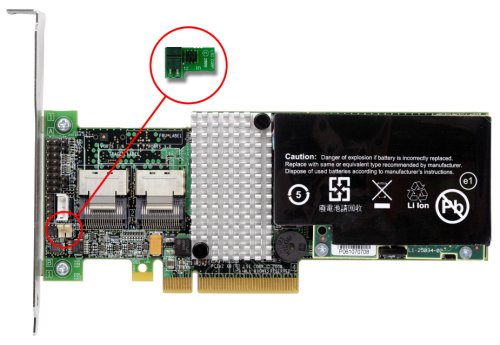
Figure 1. The ServeRAID M5000 Series Performance Accelerator Key and the ServeRAID M5015 SAS/SATA Controller
Did you know?
The M5000 Series Performance Accelerator Key is ideal for supporting server mission-critical applications where high levels of sustained read and write operations are required (such as video streaming, web content, video-on-demand, security and surveillance, fixed content, and reference data storage). It provides performance optimization for SSDs, enables data tiering, and provides important data recovery features to safeguard valuable data. Additionally, the accelerator key provides RAID 6 and 60 and SED support.
Part number information
Table 1 lists the ordering part number and feature code.
Table 1. Ordering part number and feature code
| Description | Part number | Feature code |
| ServeRAID M5000 Series Performance Accelerator Key | 81Y4426 | A10C |
The ServeRAID M5000 Series Performance Accelerator Key option part number includes the following items:
- One ServeRAID M5000 Series Performance Accelerator Key
- Quick Install Guide
- The Important Notices document
Features
ServeRAID M5000 Series Performance Accelerator Key adds the following performance and data protection enhancements to the standard ServeRAID products:
- MegaRAID FastPath: An I/O accelerator that doubles the I/O operations per second (IOPS) on solid-state drives (SSDs)
- MegaRAID CacheCade: A data-tiering enabler to support hybrid environments of SSDs and HDDs, realizing higher levels of performance
- MegaRAID Recovery: A data recovery feature that works both in pre-boot and OS environments and provides snapshot capabilities for file-level and volume-level data restoration
- LSI SafeStore: Utility for enabling encryption and storing drive keys for self-encrypting drives (SEDs)
- RAID 6 and 60 support: Additional RAID levels for added data protection
Figure 2 shows the location where the Performance Accelerator Key is installed on the adapter.
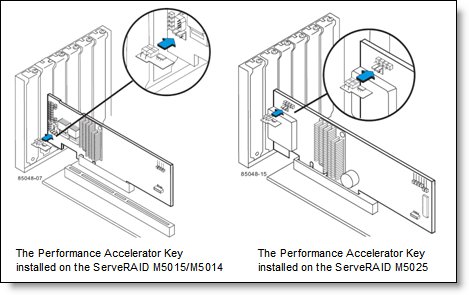
Figure 2. Location of the Performance Accelerator Key on the supported adapters
Supported ServeRAID controllers
Table 2 lists the ServeRAID SAS/SATA controllers that support the Performance Accelerator Key.
Table 2. Supported ServeRAID controllers
| ServeRAID M5000 Series Performance Accelerator Key | Y | Y | Y | N | N | N | N | N | N | N | N | N | N | N | N |
The minimum firmware level required for the supported adapters to enable the use of the Performance Accelerator Key is v12.7.0-0020. The latest firmware is available from:
http://ibm.com/support/entry/portal/docdisplay?lndocid=MIGR-5073015
The ServeRAID M5000 Series Performance Accelerator Key cannot be installed at the same time as the ServeRAID M5000 Series Advanced Feature Key, 46M0930. The Advanced Feature Key must be removed before the Performance Accelerator Key is installed. The functions of the Advanced Feature Key are provided by the Performance Accelerator Key. No further migration steps are needed.
Supported servers
The ServeRAID M5000 Series Performance Accelerator Key is supported on the System x servers listed in Table 2.
Table 2. Supported System x servers (part 1)
| ServeRAID M5000 Series Performance Accelerator Key | 81Y4426 | N | N | Y | N | Y | N | N | Y | Y | N | N | Y | Y |
Table 2. Supported System x servers (part 2)
| ServeRAID M5000 Series Performance Accelerator Key | N | Y | Y | N | N | N | N | Y | Y | N | Y | N | N | N | N | Y |
See the ServerProven website for the latest information about the adapters supported by each System x server type:
http://www.lenovo.com/us/en/serverproven/
Once the hardware key has been installed on the controller, the Recovery, Safestore, and CacheCade Features can be configured through the WeBIOS or MegaRAID Storage Manager Utilities. Figure 3 shows the LSI MegaRAID Storage Manager Dashboard View.
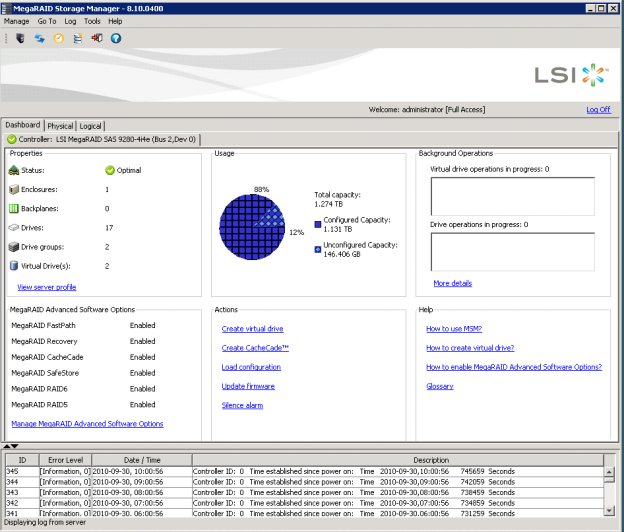
Figure 3. LSI MegaRAID Storage Manager Dashboard View
MegaRAID Recovery
MegaRAID Recovery enhances the ServeRAID data protection feature set by offering snapshot functionality that allows users to capture source volume data changes and either Restore-from-View or Rollback to a previous point in time (PiT) should accidental or malicious data deletion or infection occur. While traditional overnight backups continue to be the preferred method for creating physical copies of data for offsite or archival purposes, MegaRAID Recovery meets a growing need for more frequent backups and reduced recovery times. By supplementing traditional backup methods with MegaRAID Recovery, IT organizations can greatly enhance their level of business continuity, data protection, and restore capabilities.
How MegaRAID Recovery works
MegaRAID Recovery preserves the state of information stored on a virtual drive at a specific point in time using a copy-on-write methodology. This means that when data is written to a designated volume or virtual drive (VD), the original data that was present before being written over is then copied to a snapshot repository. The VD will continue to accept new data while copying original data to the repository. The snapshot repository will then continue to collect the original data that is being written over until a snapshot event takes place. Once a snapshot is taken, all of the new and old data on the VD becomes original data. So the repository never becomes a complete copy of the source VD.
Figure 4 shows a server with three VDs and a single snapshot repository.

Figure 4: Server with three VDs and a single snapshot repository
As snapshots are taken and the repository fills with different PiTs, MegaRAID Recovery is able to restore a VD's data should volume or file-level corruption or deletion occur. Recovery offers two methods for restoring data:
- Restore from View: Allows users to conveniently mount a view of the snapshot in MSM and drag-and-drop lost data and files back into the source data volume
- Rollback: Allows users to quickly return the application to a previous point in time, prior to infection or malicious data corruption, without requiring re-installation of the application
No data movement
One of the key advantages of MegaRAID Recovery is its ability to create PiTs without physically duplicating data. By simply opening up a new volume that keeps track of any changes to data in the source volume, MegaRAID Recovery avoids the physical movement or copying of data, enabling each PiT to be created in seconds, regardless of the size of the source volume.
Space-efficient snapshots
Each MegaRAID Recovery PiT volume snapshot is a fraction of the original volume size, because it only keeps track of the changes that are made to a volume after the PiT is created. Disk space for PiTs is pre-allocated (reserved as the Snap Repository), and the PiT is expanded in small increments as new data is written to the volume. Multiple PiTs of each volume can be retained online, enabling frequent snapshots to be stored in a space-efficient manner.
Reduce IT costs and improve data protection
Communication and file-sharing applications encounter many changes in the data throughout the day. Most small and medium businesses (SMBs) have limited IT resources and can only run data backups once every 24 hours, most of which occur overnight. This longer backup cycle increases the risk that important changes made during the day are lost before the next backup occurs. MegaRAID Recovery allows for quick and frequent snapshots of data to be taken with a only a few mouse-clicks, limiting reliance on dedicated IT resources.
Boot volume protection
MegaRAID Recovery also offers a convenient way to implement additional boot volume protection. By isolating a server’s boot volume to a separate virtual drive and enabling the Auto Snapshot feature, users can be guaranteed that bootable snapshots exist, should OS corruption occur. If, for any reason, the boot volume gets corrupted, the user can reboot, and within WebBIOS, choose the last known good snapshot (PiT) and roll back the boot volume. If there is a malicious file present that has created the corruption on the boot volume, administrators can roll back to a PiT before the malicious file was present. The additional boot volume protection from MegaRAID Recovery provides a more convenient way to re-enter an operating system and debug corruption issues.
Microsoft Volume Shadow Copy Service provider support
The Volume Shadow Copy Service (VSS) provides the backup infrastructure for the Microsoft Windows XP and Microsoft Windows Server 2003 operating systems. VSS has native support, using a standard set of application programming interfaces (APIs) for creating consistent point-in-time copies of data, regardless of the snapshot technology or application. As a certified Microsoft VSS Provider, MegaRAID Recovery can be initiated by VSS in order to create PiT volume snapshots on demand. This functionality provides a straight-forward and standard way to produce clean snapshots of a volume while coordinating with different types of business applications, file-system services, backup applications, and storage hardware.
MegaRAID FastPath
MegaRAID FastPath is a high-performance IO accelerator for solid state drive (SSD) arrays connected to a ServeRAID controller card. This advanced software is an optimized version of ServeRAID technology that can dramatically boost storage subsystem and overall application performance -- particularly those that demonstrate high random read/write operation workloads -- when deployed with a M5000-series controller connected to SSDs.
Enabling MegaRAID FastPath
Enabling MegaRAID FastPath does not require any special configuration. Simply connect the Performance Accelerator Key to the ServeRAID controller and MegaRAID FastPath will be enabled. As the user implements SSDs into an array, he should see a significant increase in overall application performance. Application workloads that will benefit most from MegaRAID FastPath with SSD volumes are those with small and random I/O patterns requiring high transactional throughput, such as OLTP.
RAID 0 random workload performance
With MegaRAID FastPath enabled, SSD configurations tuned for small, random block-size IO activity — typical of transactional database applications — can sustain over 150,000 I/O reads per second in RAID 0 configurations. This is two times the transactional performance of identical configurations when the MegaRAID FastPath software is disabled. This is particularly evident in 4 K random reads and random writes, as well as 4 K and 8 K OLTP transaction-oriented benchmarks.
In Figure 5, note that in the standard mode where MegaRAID FastPath software is not enabled, arrays are able to reach more than 80,000 IOPs. This is due to additional performance tuning optimizations over previous 6 Gbps MegaRAID SATA+SAS generations. However, with the MegaRAID FastPath software enabled, users can experience more than a 70% increase in IOPs throughput.
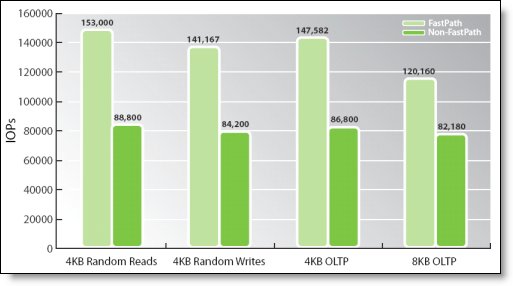
Figure 5. Performance benefits of having MegaRAID FastPath enabled (light green) versus disabled (dark green) - RAID 0 random workloads
RAID 5 random workload performance
In Figure 6, read performance in RAID 5 configurations demonstrates similar IOP performance as RAID 0. When comparing RAID 5 write performance, MegaRAID FastPath software demonstrates 2.5 times the IOP's performance over an identical configuration with this feature disabled.
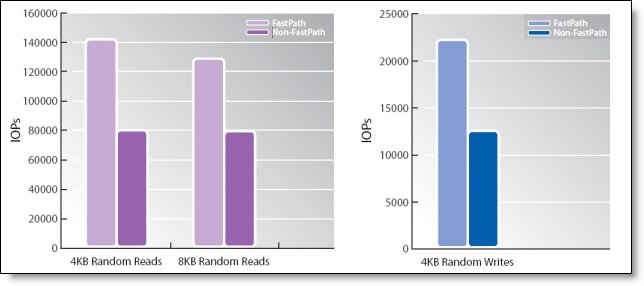
Figure 6. Performance benefits of having MegaRAID FastPath enabled (lighter color) versus disabled (darker color) - RAID 5 random workloads
RAID 0 application performance
MegaRAID FastPath software significantly boosts server application performance levels for typical workloads as well. MegaRAID controllers with MegaRAID FastPath software disabled are limited to 80,000 IOPs, whereas application performance improves by up to 45% with MegaRAID FastPath software enabled (Figure 7).

Figure 7. Typical workloads - RAID 0
MegaRAID CacheCade
MegaRAID CacheCade software allows customers to blend inexpensive SATA or SAS hard disk drives (HDDs) with a small amount of solid state storage capacity to provide a substantial performance boost while avoiding complete 1:1 replacement of SATA HDDs with faster SAS HDDs, adding additional SATA HDDs or moving to an all-SSD RAID volume to achieve performance requirements. This combination of HDDs and SSDs as secondary cache helps improve IOPs per dollar, particularly in random read-intensive applications. Simply select an SSD and associate it with one or more virtual drives to configure and use CacheCade software.
How CacheCade works
Certain applications access different data sectors more frequently than other data sectors. By determining which data is accessed more frequently, it is possible to move the more frequently accessed data to a faster media, allowing for faster overall READ performance from the controller. CacheCade software allows for frequently read data (hot-spot) to be moved to second-tier SSD cache for much faster retrieval of that data when it is time for it to be re-read. This provides significant performance improvement of 2x to 50x for read-intensive applications such as web, file, SQL, and other transactional server applications
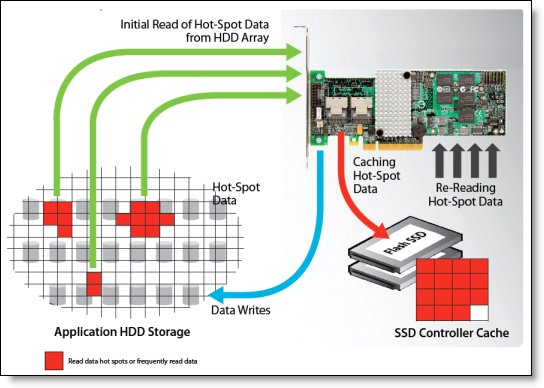
Figure 8. CacheCade in action
Enabling CacheCade
Once the Performance Accelerator Key is connected to the M5000 Series Controller, CacheCade can be configured through the MegaRAID Storage Manager Utility. When configuring for CacheCade, it is necessary to make sure that no volume data be stored on the available SSDs prior to creating the SSD cache.
Performance impact
CacheCade uses SSDs to super-swell the M5000 Series controller cache. As with any other SSD caching implementation, the amount of performance improvement that is achieved differs depending on the application that is running. For this generation, users will see greater performance gains in READ-intensive applications.
Supported operating systems
The ServeRAID M5000 Series Performance Accelerator Key supports the operating systems that are supported by the ServeRAID controllers:
- Microsoft Windows Server 2003, Web Edition
- Microsoft Windows Server 2003/2003 R2, Datacenter Edition
- Microsoft Windows Server 2003/2003 R2, Datacenter x64 Edition
- Microsoft Windows Server 2003/2003 R2, Enterprise Edition
- Microsoft Windows Server 2003/2003 R2, Enterprise x64 Edition
- Microsoft Windows Server 2003/2003 R2, Standard Edition
- Microsoft Windows Server 2003/2003 R2, Standard x64 Edition
- Microsoft Windows Server 2008 R2
- Microsoft Windows Server 2008, Datacenter x64 Edition
- Microsoft Windows Server 2008, Datacenter x86 Edition
- Microsoft Windows Server 2008, Enterprise x64 Edition
- Microsoft Windows Server 2008, Enterprise x86 Edition
- Microsoft Windows Server 2008, Standard x64 Edition
- Microsoft Windows Server 2008, Standard x86 Edition
- Microsoft Windows Server 2008, Web x64 Edition
- Microsoft Windows Server 2008, Web x86 Edition
- Microsoft Windows Small Business Server 2003/2003 R2 Premium Edition
- Microsoft Windows Small Business Server 2003/2003 R2 Standard Edition
- Red Hat Enterprise Linux 4 AS for AMD64/EM64T
- Red Hat Enterprise Linux 4 AS for x86
- Red Hat Enterprise Linux 4 ES for AMD64/EM64T
- Red Hat Enterprise Linux 4 ES for x86
- Red Hat Enterprise Linux 4 WS/HPC for AMD64/EM64T
- Red Hat Enterprise Linux 4 WS/HPC for x86
- Red Hat Enterprise Linux 5 Server Edition
- Red Hat Enterprise Linux 5 Server Edition with Xen
- Red Hat Enterprise Linux 5 Server with Xen x64 Edition
- Red Hat Enterprise Linux 5 Server x64 Edition
- SUSE LINUX Enterprise Server 10 for AMD64/EM64T
- SUSE LINUX Enterprise Server 10 for x86
- SUSE LINUX Enterprise Server 10 with Xen for AMD64/EM64T
- SUSE LINUX Enterprise Server 11 for AMD64/EM64T
- SUSE LINUX Enterprise Server 11 for x86
- SUSE LINUX Enterprise Server 11 with Xen for AMD64/EM64T
- VMware ESX 4.0
- VMware ESXi 4.0
See the ServerProven website for the latest information about the specific versions and service packs supported: http://www.lenovo.com/us/en/serverproven/. Click System x servers, then Disk controllers to see the support matrix. Click the check mark that is associated with the System x server in question to see the details of the operating system support.
Trademarks
Lenovo and the Lenovo logo are trademarks or registered trademarks of Lenovo in the United States, other countries, or both. A current list of Lenovo trademarks is available on the Web at https://www.lenovo.com/us/en/legal/copytrade/.
The following terms are trademarks of Lenovo in the United States, other countries, or both:
Lenovo®
ServerProven®
System x®
The following terms are trademarks of other companies:
Linux® is the trademark of Linus Torvalds in the U.S. and other countries.
Microsoft®, Windows Server®, and Windows® are trademarks of Microsoft Corporation in the United States, other countries, or both.
ibm.com® is a trademark of IBM in the United States, other countries, or both.
Other company, product, or service names may be trademarks or service marks of others.
